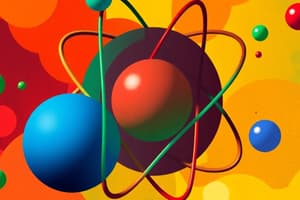Podcast
Questions and Answers
Which subatomic particle was discovered by James Chadwick in 1932?
Which subatomic particle was discovered by James Chadwick in 1932?
- Positrons
- Protons
- Electrons
- Neutrons (correct)
What is the charge of an electron?
What is the charge of an electron?
- Positive charge
- Negative charge (correct)
- Neutral charge
- No charge
Who proposed the atomic theory that atoms are indivisible and neutral particles known as neutrons?
Who proposed the atomic theory that atoms are indivisible and neutral particles known as neutrons?
- J.J. Thomson
- Ernest Rutherford
- John Dalton (correct)
- James Chadwick
What type of particles make up cathode rays?
What type of particles make up cathode rays?
Which scientist observed streams of heavy particles emitted from the anode, known as canal rays?
Which scientist observed streams of heavy particles emitted from the anode, known as canal rays?
What is the approximate mass of a neutron?
What is the approximate mass of a neutron?
Which subatomic particle is approximately 2000 times heavier than an electron?
Which subatomic particle is approximately 2000 times heavier than an electron?
In what year were electrons first identified by J.J. Thomson?
In what year were electrons first identified by J.J. Thomson?
Match the scientist with their contribution to the understanding of atomic structure:
Match the scientist with their contribution to the understanding of atomic structure:
Match the subatomic particle with its characteristic:
Match the subatomic particle with its characteristic:
Match the year with the corresponding scientific discovery:
Match the year with the corresponding scientific discovery:
Match the property with the correct subatomic particle:
Match the property with the correct subatomic particle:
Study Notes
- Dalton's atomic theory revolutionized the understanding of matter by suggesting that atoms are indivisible and neutral particles known as neutrons.
- Cathode rays experiment by J.J. Thomson in 18971 showed the existence of negatively charged particles, later identified as electrons.
- Thomson's experiment with a discharge tube and high voltage led to the discovery of cathode rays consisting of small negatively charged particles called electrons.
- Goldstein's experiment, similar to Thomson's, observed streams of heavy particles emitted from the anode, known as canal rays, consisting of positively charged particles ultimately identified as protons.
- Neutrons were discovered by James Chadwick in 1932, revealing them as neutral particles with no charge and a mass of 1.6 * 10^-27 kg.
- Electrons have a mass of 9 * 10^-31 kg and a negative charge of 1.6 * 10^-19 C, while protons have a positive charge of the same magnitude.
- Protons are approximately 2000 times heavier than electrons and carry a positive charge of 1.6 * 10^-19 C.
- Neutrons, being neutral particles, have no charge and a mass of 1.6 * 10^-27 kg.
- The discovery of these subatomic particles (electrons, protons, neutrons) transformed the understanding of atomic structure and composition.
- These experiments laid the foundation for modern chemistry and physics, providing crucial insights into the composition and behavior of atoms.
Studying That Suits You
Use AI to generate personalized quizzes and flashcards to suit your learning preferences.
Description
Test your knowledge of the groundbreaking experiments that led to the discovery of subatomic particles such as electrons, protons, and neutrons. Explore the contributions of scientists like J.J. Thomson, Ernest Rutherford, and James Chadwick to our understanding of atomic structure.




